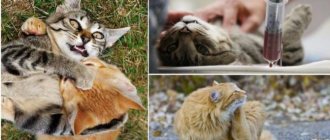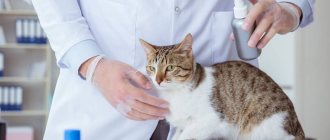The danger of all viral infections lies in their extraordinary survivability and speed of reproduction. To avoid death if infected, veterinarians recommend vaccinating pets against the most common diseases in advance. In Russia, only one vaccination is required - it is given against rabies (hydrophobia) in cats in order to prevent further spread of the pathogenic microorganism.
Source of rabies
The causative agent of the disease, which is fatal to cats, is the Rabies virus . It is he who disorganizes the work of the central nervous system. Having penetrated the body, the rabies pathogen moves along nerve fibers to the brain, and then rushes to the salivary glands. In them it accumulates and multiplies.
Moreover, the virus has strong immunity: at a temperature of 90 degrees Celsius it can live up to 14 days, and even longer when exposed to cold.
For this reason, cat owners should carefully ensure that their pet does not pick up any food from the street.
Pathogen and routes of infection
The causative agent of rabies is a neurotropic virus of the Rhabdoviridae family - Rabies virus. This is a cylindrical microorganism measuring 180x75 nm, having a shell and a ribonucleoprotein core containing genetic information. Rabies virus is resistant to sub-zero temperatures and remains viable for several months when frozen. However, the virus dies very quickly, within a few minutes, when irradiated with ultraviolet light, treated with disinfectants and heated to 100 °C.
The pathogen is transmitted from a sick animal through a bite or contact of saliva with damaged areas of the skin or mucous membranes. From the site of infection, the virus penetrates the spinal cord and brain, where it localizes, multiplies and causes damage to nerve cells. The result is severe disruption of the central and peripheral nervous system, and then other organs. The carriers of infection are most often wild animals (hedgehogs, foxes, bats), and in populated areas - stray cats or dogs.
How does infection occur?
A cat can be infected with rabies only through saliva , while eliminating the risk of infection through blood or urine. Moreover, a sick animal does not necessarily have to bite a cat. If the saliva of an infected organism suddenly ends up on a cat’s wound or scratch (even if it is small), then there is already a serious possibility of developing hydrophobia. Hypothetically, a pet could get rabies simply by licking its owner's shoes, since it is quite easy to bring saliva from an infected animal from the street.
When eating rats or mice infected with rabies, the likelihood of the cat becoming ill is quite high.
Is there a cure for cat rabies?
If the veterinarian determines that the animal's symptoms are not due to rabies, the pet is treated.
If the diagnosis is confirmed and the cat is truly infected, he is euthanized.
Unfortunately, rabies cannot be treated - sick animals are euthanized
All people who came into contact with the cat are prescribed anti-rabies treatment.
Since possible treatment of a pet has a very high probability of infection of the medical staff of the veterinary clinic, treatment of animals with this diagnosis is not carried out.
Incubation period
From the moment of infection until the appearance of primary signs of rabies, an average of 21–42 days . However, the duration of the incubation period depends on several factors: location, localization, size of the bite, age. For kittens, the above time period is 6–7 days . But even after this period, it is not always possible to determine exactly whether a cat has rabies.
Once a case was recorded when, only 6 months after the bite, specialists were able to diagnose a fatal pathology in a cat.
The smaller the bite area and the further it is located from the pet’s brain, the longer the incubation period for the virus. Not least important here is the dose of the virus in saliva.
Even a cat that has been vaccinated against rabies at one time can potentially become an object of infection (especially if the vaccination was done more than six months ago).
Important! There are cases when, even after a control period of time, nothing suspicious is detected in the pet’s behavior, but its saliva is, de facto, toxic.
This is why it is recommended to quarantine your cat immediately after being bitten and seek immediate treatment from your local veterinarian. Ignoring these measures risks infecting the owner himself with rabies, and treatment of this dangerous disease can turn into a long and painful procedure.
What to do if your cat is bitten?
If the owner of a pet is faced with the problem of biting, then he needs to take appropriate precautions. The person who will handle the animal must wear gloves and thick clothing to prevent the cat from biting or scratching their hands. After a bite, the animal is in a stressful state, so treating wounds can provoke an attack of aggression. Near the site of the bite, you need to cut off the hair, wash the wound first with soap and water, then with warm running water.
The bite site is wiped with a solution of iodine or alcohol. If the animal has not been vaccinated or it was done more than 12 months ago, then the cat is placed under quarantine. The pet is observed for 3-5 days. If characteristic symptoms appear (apathy, refusal to eat), you should immediately contact a veterinarian. If the animal has not been vaccinated, then immediately after the bite you need to call a veterinarian who will perform an urgent vaccination and explain to the owner how rabies manifests itself in a cat.
If signs of rabies appeared while the pet was in quarantine, the owner must notify the nearest government veterinary clinic. If the doctors' suspicions are confirmed, the animal is euthanized and the material (part of the brain) is taken for analysis.
Once signs of infection have been identified, a person who has regular contact with the animal should disinfect it with soap or any other disinfectant. It is best to burn the clothing that a person was wearing at the time of contact with an infected animal.
General signs of infection
A characteristic feature of the virus is the fact that after entering the body, it may not manifest itself for weeks or even months. As a rule, the initial symptoms occur when the disease is firmly rooted in the body and subjugates the main vital systems.
There are some changes in the cat's behavior:
- excessive aggressiveness accompanied by anxiety;
- suspicious calm;
- slow reaction;
- unusual screams;
- meowing too often;
- systematic paralysis, convulsions;
- loss of appetite;
- photophobia (the cat hides in dark places);
- increased salivation.
The above list is not exhaustive and the manifestation of certain signs depends on the degree of infection of the pet.
Forms of disease development and their symptoms
There are several variations in the development of rabies in a domestic animal, the causative agent of which is a virus. Moreover, in kittens the stages of the disease in question are the same as in adults, but they proceed somewhat faster.
Paralytic (silent) form
The period of this type of disease is 3-4 days . Moreover, no deviations are observed in the pet’s behavior , except for the fact that he is systematically overcome by attacks of affection . However, one should not show loyalty to such friendliness on the part of the cat, since its saliva is poisoned by the virus.
Those at greatest risk are children who, noticing the playful mood of the cat, begin to stroke and pick it up. During the period of a silent form of rabies, your pet may experience drooping of the lower jaw and increased salivation .
Soon paralysis of the larynx sets in, and the cat begins to choke. Family members naively believe that there is simply a bone stuck in the pet’s throat and begin to try to remove it with their own hands. Only after several unsuccessful attempts do they decide to take the cat to the veterinarian, who subsequently informs them of the terrible diagnosis.
Violent form
The duration of this variation in the development of rabies varies from 3 to 11 days . It is characterized by even more pronounced symptoms. The first sign indicating that rabies has become violent is a significant change in the cat’s behavior, which is no longer explained. There are three stages here.
Prodormal
Symptoms indicating this stage are quite difficult to determine. In essence, we are talking about the incubation period, the specifics of which were described above. A rabid cat loses its appetite , it shuns the light and makes every attempt to retire . She develops an unusual hobby: tasting inedible things - paper, curtains, tree bark, etc. As already emphasized, in the initial stage of infection, a pet may show excessive playfulness and friendliness , so this behavior should be alarming in the first place.
Manic
The signs by which this stage can be determined are pronounced, so recognizing it will not be difficult. Any noise and commotion from others provokes an open attack of aggression in the cat. At this moment, he is ready to rush at the first one who catches his eye. In time, the manic stage is short-lived: only a few hours , which can transform into a maximum of 2-3 days .
The animal clearly exhibits a “gnawing” reflex . The cat takes into its mouth everything it comes across, starting with slippers and ending with a broom. Moreover, she doesn’t just take bites, but tries to squeeze her jaws as tightly as possible . The pet is systematically subjected to bouts of unexpected and sudden attacks on family members, which is fraught with serious bites for them, through which rabies is transmitted.
In addition, the animal's swallowing reflex is impaired , resulting in increased salivation. Eating and drinking become difficult for the cat. The animal begins to experience real fear when it hears the sound of water.
Depressed
At the final stage of the development of rabies, which lasts 5–7 days , paralysis of the larynx and pharynx . The voice ceases to be loud, then disappears altogether, and the body gradually loses the ability to move. The aggressive reflex is reduced to a minimum. The animal's body becomes exhausted and it dies.
Atypical form
This type of rabies development is classified as rare , although its duration sometimes reaches several months. It is difficult to determine the atypical form, since the symptoms are mild .
The pet experiences drowsiness, lethargy, and depression. The cat suffers from intestinal dysfunction, resulting in loose bowel movements with blood and vomiting. The pet's body is seriously depleted.
How often do cats get a rabies injection and who is the vaccine contraindicated for?
Kittens are vaccinated at the age of 3 months. Adults must undergo an important procedure annually. Do not forget that the doctor only vaccinates animals that have been previously treated against parasites (helminths, fleas, ticks). It is prohibited to administer the vaccine to pregnant females and pets who have suffered a protracted illness.
photo from website: vseprivivki.com
Modern means of protection against the virus are effective and do not cause side effects. They are equally well tolerated by both adults and kittens.
What to do if you suspect rabies?
If you have serious reasons to believe that your cat may be infected, take the following measures immediately
- complete refusal of contact with the animal and 100% isolation of the latter (in a separate room);
- if the cat has bitten or scratched the skin, then urgently wash the wound using laundry soap;
- contacting a veterinary clinic and consulting with a specialist about your pet’s symptoms.
Important! Neglecting the above recommendations may result in infection with the rabies virus.
Is there a cure for rabies in cats?
There is no cure for this dangerous disease. The animal cannot be saved even after early diagnosis. If characteristic symptoms are detected, it is recommended:
- Isolate your pet in a separate room and monitor all changes that occur to it.
- Do not conduct a self-examination and contact the staff of a veterinary clinic or city emergency room.
- Prepare a veterinary passport with vaccination marks, if available.
- Avoid any contact with the infected person until doctors arrive.
The most humane solution for a stable deterioration of the patient’s condition is euthanasia, which saves the animal from the painful development of the disease. Some veterinarians believe that if this procedure is abandoned, the percentage of successful self-healing in the abortive form may increase. There is no rush to test this theory, since the chances are very small, and the owners do not intend to endure the torment of their mustachioed pet.
Diagnostics
As has already been emphasized, it can be very difficult to determine as accurately as possible that a cat is infected with rabies. In most cases, the veterinarian resorts to specific actions only when, after analyzing the pet’s symptoms, he concludes that he is sick with something other than the rabies virus.
Otherwise, the veterinarian chooses a wait-and-see approach until the animal is declared dead. Only after this the specialist begins to study the animal’s brain tissue to find out whether its structure contains the “Babesh-Negri” body. If the test is positive, everyone who previously had contact with the cat is prescribed appropriate therapy.
The corpse of an infected pet is necessarily burned.
As for medications that would relieve a pet from rabies, humanity has not yet invented them.
Is it dangerous for humans?
Is a cat with rabies dangerous for humans? Definitely yes! Can the disease be transmitted from a scratch? This is unlikely, since we have already found out that the disease is transmitted only through saliva. However, if you come into contact with a cat with rabies, don't push your luck and consult a doctor. What if a cat bites? This situation is certainly dangerous for humans. Microorganisms will definitely get into the wound, and there will be inflammation. The minimum is redness of the skin, the maximum is a dangerous disease (including rabies).
However, during the incubation period, it is impossible for a person to become infected with rabies from a cat. The virus is not yet in saliva. In the first stage, it just begins to multiply in the salivary glands, but there is already a risk of infection. But when a cat is clearly in the second (manic) stage of rabies, a whisker bite is extremely dangerous for a person. If you do not start treating a person on time (immediately after the bite, before any symptoms appear), then death will be very painful and inevitable.
Prevention measures
The most effective way to minimize the risk of infection in a cat is through vaccination. The cost of vaccination against the virus is 700–900 rubles.
The veterinary market offers several effective remedies that reduce the risk of rabies infection. We are talking, in particular, about “Nobivak Rabies”, “Quadriquet”, “Rabican”, “Leucorifeline”. All of them have virtually no side effects, but the most popular is the first of these drugs.
At what age is it recommended to start vaccination? As soon as the kitten turns 3 months old. Moreover, your pet needs to be vaccinated annually. You can read about how to inject your cat yourself in our article.
Rabies vaccination is a free service that is provided by all budget veterinary clinics without exception.
Vaccination is not advisable if:
- pregnancy or if the cat has just lambed;
- the presence of helminths in the body (before vaccination, all parasites must be removed);
- if the kitten has not had teeth replaced;
- the animal is injured.
Important! In all civilized countries of the world, cats are required to be vaccinated against rabies. And if the pet’s owners ignore this rule, then they will not be able to leave the country with it. Also, a pet will not be allowed to the exhibition if there is no corresponding vaccination mark in the veterinary passport.
What to do if your pet is sick?
The only correct choice is to euthanize the infected individual. There are no medications or treatments in veterinary medicine that can treat rabies in cats.
The risk of contracting a dangerous disease is great not only for other animals, but also for the owner. By putting your pet to sleep, you will be able to prevent further transmission of the infection and save your pet from inevitable suffering.
Diet for the duration of treatment
The risk of contracting rabies is high not only for other animals, but also for the owner.
Blood purifying products will help cleanse the body of a dangerous virus:
- red fruits, berries and vegetables;
- garlic and spinach;
- fatty fish;
- green tea;
- nuts;
- fresh juices.
Due to the fact that rabies provokes paralysis of the muscles of the larynx, all products must be pureed until they become mushy.
Useful video:
A veterinarian's opinion about rabies in cats: the course of the disease and its symptoms.
Today, the rabies virus poses perhaps the greatest threat to animals and humans. Megacities are especially susceptible to episodic outbreaks of rabies, and it would be naive to expect that living remotely from them will guarantee one’s safety for life and health.
Every day, about 100 people die from hydrophobia. This figure exceeds 50,000 per year, and the number of dead animals amounts to several million. These terrifying statistics are explained by the fact that in 99% of cases, pets infected with rabies do not survive.
It is for this reason that your pet needs to be systematically vaccinated to minimize the risk of contracting hydrophobia.











